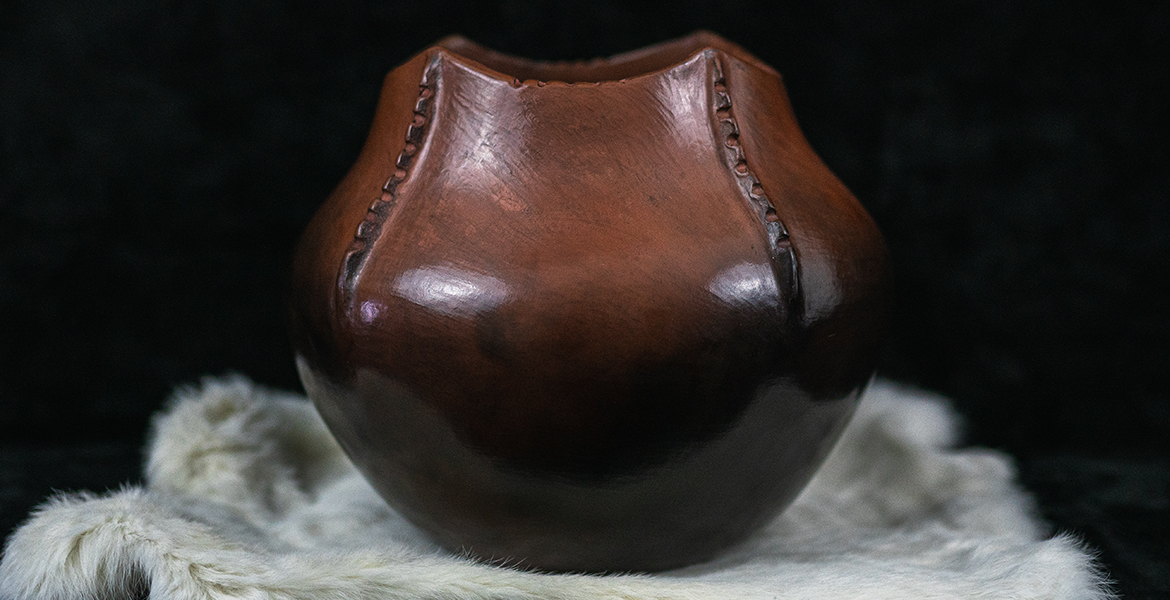
Focus on Native American Art: Jane Osti
Monday, November 23, 2020
Potter and Cherokee National Treasure Jane Osti will soon have one of her pieces, a traditional Cherokee cooking pot, on display in the OSU College of Osteopathic Medicine at the Cherokee Nation, which she sees as a perfect fit.
“Any opportunity I have to educate people about our pottery and what we used it for and how significant it was in our lives is great. To me, food is pretty close to medicine,” she said because what we eat and how we feel are so closely related.
The new facility located in Tahlequah is the first tribally affiliated medical school site in the country. In addition to classrooms, clinical skills labs and a simulation center, the building will also house 125 pieces of Native American art.
Osti’s piece that will be showcased at the new site is a traditional Cherokee cooking pot made from red Earthenware clay. She made the piece using the Cherokee coil building method, then polished it with a stone until it was shiny before kiln firing and finally wood firing the pot.
Pottery pieces created using this method can take weeks to make start to finish, but it’s the art medium she enjoys the most.
“Ninety-nine percent of what I do is clay pottery,” she said. “I start out with an idea sometimes, but I kind of just let the clay lead me. The foundation of my art is always based on prehistoric pottery. There’s something in my pieces that represents something from our old pottery.”
Osti’s love of the medium was sparked while pursuing her bachelor’s in fine arts from Northeastern State University in Tahlequah.
“I was finishing up my bachelor’s degree and one of the classes I had to take was pottery and sculpture,” she said. “I absolutely loved it. It was pretty overwhelming. I did it day and night for years and years. I knew it’s what I wanted to do immediately.”
It was in that class where she also met Anna Mitchel, a Master Potter and Cherokee National Treasure who has pieces in the Smithsonian National Museum of the American Indian.
“I learned a lot from her, she became my mentor and my friend for over 25 years,” she said.
"I feel I’ve grown as an artist from those first little attempts. And I’ve learned from a lot of people. You never stop learning."
Gina Olaya, director of Cultural Art & Design for Cherokee Nation Businesses, formed a committee of people from OSU Center for Health Sciences to select pieces submitted from Cherokee Nation artists to be showcased in the new building.
“It is my goal the students, faculty and staff learn about our Cherokee history, culture and heritage through visual art,” Olaya said.
Dr. Natasha Bray, D.O., associate dean of Academic Affairs, was one of the members of the art selection committee.
“We looked for pieces that provided an overall representation of the breadth of talent and medium used by Cherokee artists,” Bray said. “We wanted pieces that represented health, healing, medicine, wellness, family and community, but what we received was so much more.”
Dr. William Pettit, D.O, and dean of the OSUCOM at the Cherokee Nation said it’s important that the building reflect the history and culture of American Indian tribes in Oklahoma.
“This Native American artwork showcases the appreciation and respect that OSU Center for Health Sciences has for the culture and phenomenal partnership with the Cherokee Nation in developing the first tribally affiliated medical school in the United States,” Pettit said.
Having a piece in the new medical school is even more personal for Osti— she was born in 1945 at the W.W. Hastings Hospital that sits right next door to the OSUCOM at the Cherokee Nation. Having works by Cherokee artists displayed in the medical school building makes art more accessible to the students, faculty and staff, she said.
“It’s a good opportunity for us to share our culture and our art with our people. It will give more people the chance to have an art experience who may not get to go to a museum or exhibit,” she said. “A lot of students and employees who go there have relatives who have made this art and they’re proud of it. It will give them more pride in their Cherokee heritage.”
MEDIA CONTACT: Sara Plummer | Communications Coordinator | 918-561-1282 | sara.plummer@okstate.edu
